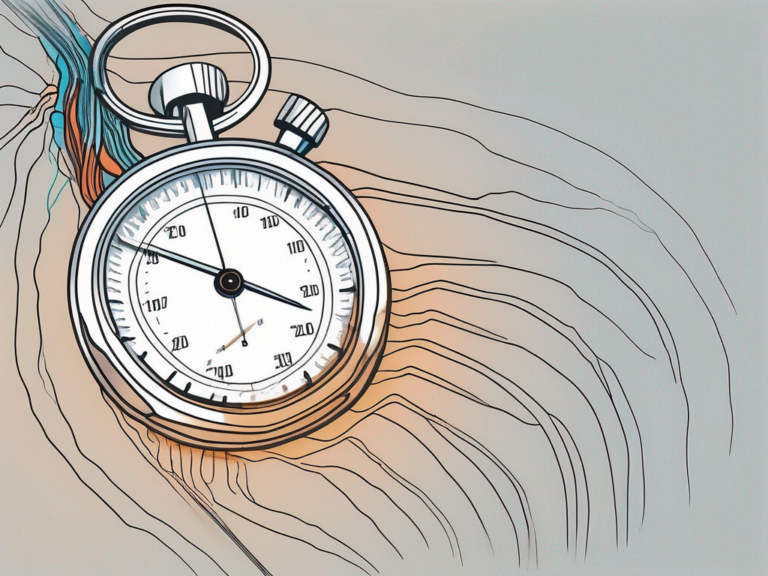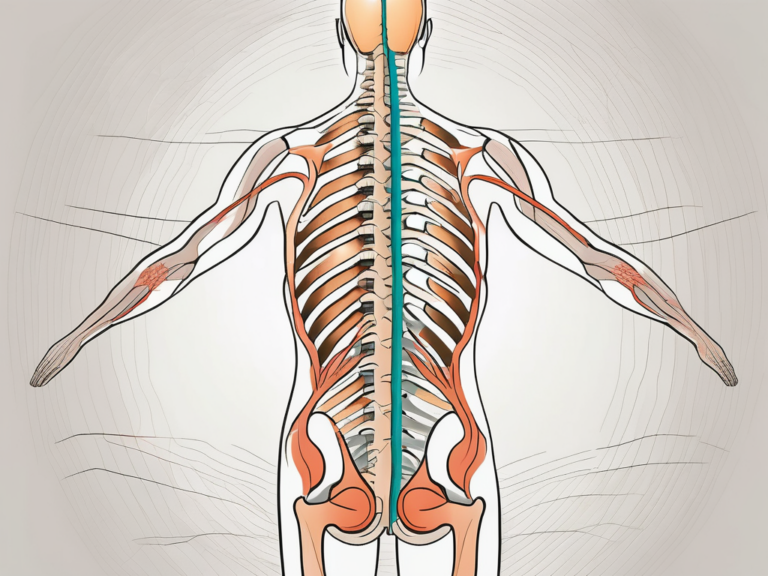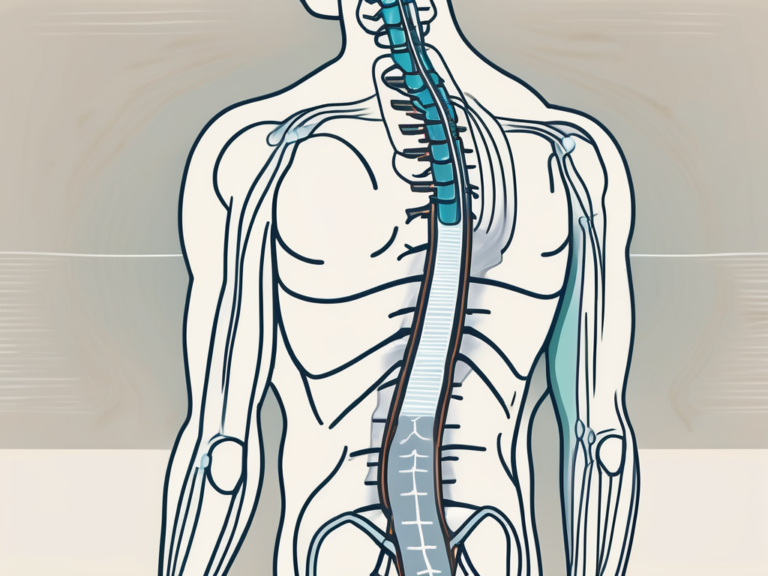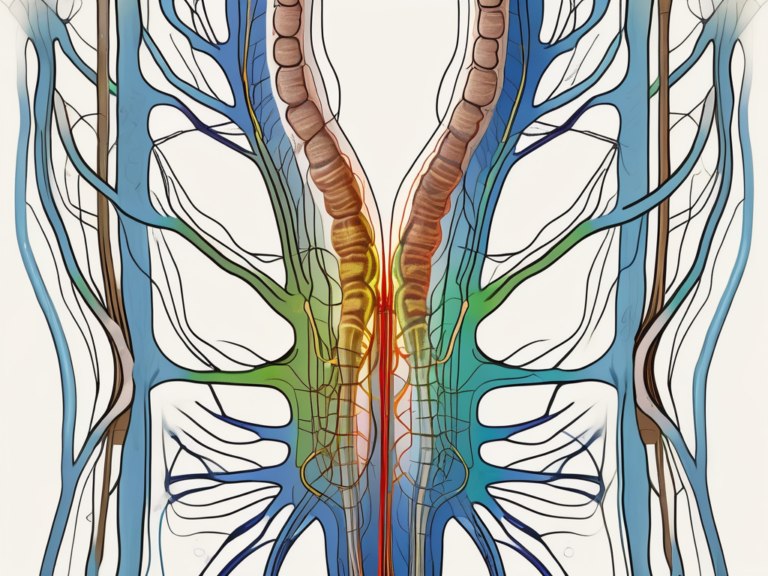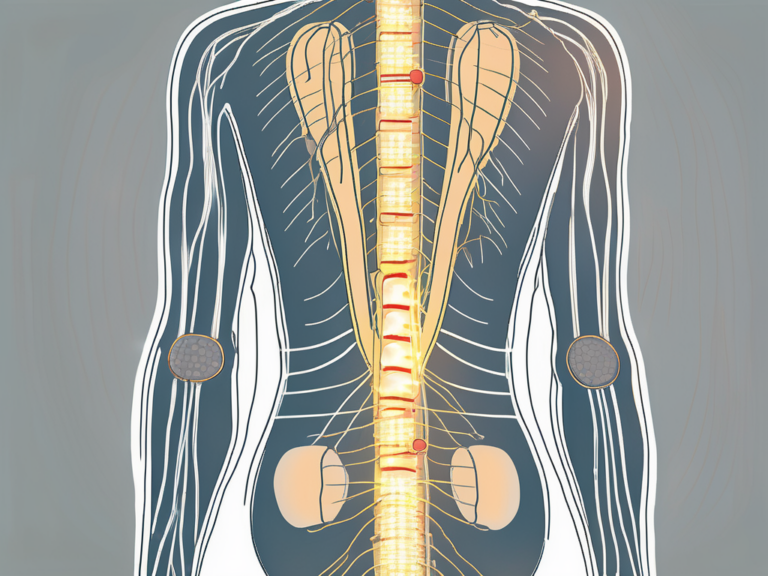Understanding the Nerve Roots in the Sacral Plexus
The sacral plexus is a complex network of nerves located in the lower back region, specifically in the sacrum. It plays a crucial role in facilitating various bodily functions and is essential for our overall well-being. In this article, we will delve deeper into the anatomy, functionality, common disorders, the impact of age and lifestyle, and future research directions related to the nerve roots in the sacral plexus.
Anatomy of the Sacral Plexus
The sacral plexus consists of a group of nerves that emerge from nerve roots in the lower back, particularly from the fifth lumbar (L5) and first four sacral (S1-S4) vertebrae. These nerve roots come together to form a complex mesh-like structure that extends down into the pelvis.
As the nerve roots join together, they create a network of fibers that intertwine and connect, forming a intricate web of communication within the body. This network allows for the transmission of signals between the brain and the lower limbs, pelvic organs, and perineum.
The sacral plexus is a crucial component of the body’s nervous system, serving as a vital link between the central nervous system and the peripheral nervous system. It plays a fundamental role in coordinating and controlling various bodily functions, ensuring the proper functioning of the lower body.
The Role of Nerve Roots in the Sacral Plexus
The nerve roots in the sacral plexus play a vital role in transmitting sensory and motor signals to and from the lower limbs, pelvic organs, and perineum. These signals facilitate important bodily functions, such as controlling the movement of the legs, bladder, and rectum, as well as sexual function.
When you take a step, the nerve roots in the sacral plexus are responsible for relaying the signals from your brain to the muscles in your legs, allowing for coordinated movement. Similarly, when you feel a sensation, such as touch or pain, in your lower body, it is the sacral plexus that carries these signals back to your brain, enabling you to perceive and respond to the stimuli.
In addition to motor and sensory functions, the sacral plexus also plays a crucial role in maintaining the autonomic nervous system, which controls involuntary bodily functions. This includes regulating the contraction and relaxation of the bladder and rectum, as well as facilitating sexual arousal and orgasm.
Key Components of the Sacral Plexus
The sacral plexus consists of several major nerves, each with its own specific functions and areas of innervation. One of the most well-known nerves in the sacral plexus is the sciatic nerve, which is the largest nerve in the body. It originates from the sacral plexus and extends down the back of the thigh, branching out into smaller nerves that innervate the muscles of the leg and foot.
Another important nerve in the sacral plexus is the pudendal nerve, which is responsible for providing sensation to the external genitalia and perineum. This nerve plays a crucial role in sexual function and is involved in the process of urination and defecation.
The superior gluteal nerve is yet another significant component of the sacral plexus. It innervates the gluteus medius, gluteus minimus, and tensor fasciae latae muscles, which are essential for maintaining stability and proper movement of the hip joint.
These nerves, along with other smaller branches, work together to ensure the smooth functioning of the lower body. They allow for coordinated movement, sensory perception, and the regulation of various bodily functions, contributing to our overall well-being and quality of life.
Functionality of the Sacral Plexus
The sacral plexus, consisting of nerve roots, plays a crucial role in facilitating various bodily functions. These nerve roots are responsible for enabling us to walk, run, and perform other physical activities by transmitting motor signals to the muscles in our lower limbs. Additionally, they carry sensory signals from the lower body, allowing us to perceive touch, temperature, and pain sensations.
But what exactly happens when we take a step or move our legs? The nerve roots in the sacral plexus come into action. They send signals to the muscles involved in the movement, initiating and coordinating the contraction and relaxation of these muscles. This seamless and coordinated movement is made possible by the intricate communication between the nerve roots and the muscles.
However, the functionality of the sacral plexus goes beyond just facilitating movement. It is also involved in the control of bladder and rectal functions. The nerve roots convey signals that enable the bladder to store and release urine effectively. They also aid in maintaining bowel control and the proper functioning of the rectum. Without the sacral plexus, these essential bodily functions would be compromised.
Interactions Between Nerve Roots and Other Body Systems
The nerve roots in the sacral plexus do not work in isolation. They interact with other body systems to ensure proper coordination and functionality. One of the key interactions is with the central nervous system, which includes the brain and spinal cord. The nerve roots communicate with the central nervous system to transmit and receive signals effectively. This communication is vital for the overall functioning of the body.
In addition to the central nervous system, the sacral plexus also interacts with the autonomic nervous system. The autonomic nervous system controls involuntary bodily functions, such as heart rate, blood pressure, and digestion. The sacral plexus helps facilitate the interaction between the autonomic nervous system and the organs it regulates. This coordination ensures that these essential functions are carried out smoothly and efficiently.
The sacral plexus is truly a remarkable part of our body. Its nerve roots enable us to move, perceive sensations, and maintain control over vital bodily functions. Without the intricate network of communication and coordination between the sacral plexus and other body systems, our daily activities and overall well-being would be greatly affected.
Disorders Related to the Sacral Plexus
Disorders affecting the sacral plexus can significantly impact an individual’s quality of life. The sacral plexus is a network of nerves located in the lower back and pelvis, responsible for transmitting signals to and from the lower extremities. When this intricate network is disrupted, it can lead to a variety of symptoms and complications.
Identifying and understanding the symptoms associated with these disorders is crucial for early diagnosis and intervention. By recognizing the signs, individuals can seek appropriate medical attention and receive timely treatment to alleviate their symptoms and improve their overall well-being.
Common Symptoms of Sacral Plexus Disorders
Sacral plexus disorders may manifest in various ways, and the symptoms experienced can vary from person to person. However, there are some common symptoms that individuals with sacral plexus disorders may experience.
One of the primary symptoms is pain, which can range from mild discomfort to severe and debilitating. This pain is often localized in the lower back, pelvis, or legs, and may be accompanied by a sensation of weakness or heaviness in the affected area.
In addition to pain, individuals may also experience numbness or tingling sensations in the lower extremities. These sensations, known as paresthesia, can be intermittent or constant and may affect one or both legs.
Changes in bladder and bowel functions are another hallmark symptom of sacral plexus disorders. Individuals may experience difficulty controlling their urine or stool, leading to urinary or fecal incontinence. This can have a significant impact on daily activities and quality of life.
Furthermore, sexual dysfunction may also be observed in individuals with sacral plexus disorders. This can manifest as a decreased libido, difficulty achieving or maintaining an erection (in males), or difficulty reaching orgasm.
Diagnosis and Treatment Options for Sacral Plexus Disorders
If you experience symptoms related to sacral plexus disorders, it is essential to consult with a qualified healthcare professional. They will conduct a thorough examination, which may include diagnostic tests to assess the extent of the condition and determine the underlying cause.
Diagnostic tests commonly used to evaluate sacral plexus disorders include nerve conduction studies, electromyography, and imaging studies such as magnetic resonance imaging (MRI) or computed tomography (CT) scans. These tests help identify any abnormalities or damage to the nerves in the sacral plexus, aiding in accurate diagnosis.
Once a diagnosis is made, treatment options for sacral plexus disorders can be tailored to meet the individual’s specific needs. The choice of treatment depends on the underlying cause and severity of the condition.
Medication is often prescribed to manage pain and reduce inflammation. Nonsteroidal anti-inflammatory drugs (NSAIDs), muscle relaxants, and neuropathic pain medications may be used to alleviate symptoms and improve overall comfort.
Physical therapy plays a crucial role in the treatment of sacral plexus disorders. Through targeted exercises and techniques, physical therapists can help improve strength, flexibility, and range of motion in the affected area. They may also provide guidance on posture and body mechanics to prevent further injury or strain.
In some cases, nerve blocks may be recommended to provide temporary relief from pain and inflammation. These blocks involve injecting medication directly into the affected nerves, effectively numbing the area and reducing discomfort.
In severe cases where conservative measures fail to provide relief, surgical intervention may be considered. Surgery aims to repair or decompress the affected nerves, restoring their normal function and alleviating symptoms.
It is important to note that the treatment approach for sacral plexus disorders should be individualized, taking into account the specific needs and preferences of each patient. A healthcare professional with expertise in this area can provide personalized treatment recommendations and guide individuals through their journey to recovery.
The Impact of Age and Lifestyle on the Sacral Plexus
As we age, the sacral plexus, like other parts of our body, undergoes certain changes. These changes can influence its functionality and overall health. Additionally, certain lifestyle factors can affect the health of the sacral plexus, either positively or negatively.
Age-Related Changes in the Sacral Plexus
With age, the nerves in the sacral plexus may become less efficient in transmitting signals, leading to decreased sensitivity and muscle control. This can result in difficulties with mobility, coordination, and bladder and bowel function. However, it is important to note that these changes are not inevitable and can be mitigated through various measures.
Regular exercise plays a crucial role in maintaining the health of the sacral plexus. Engaging in physical activities such as walking, swimming, or yoga can promote blood flow to the nerves, keeping them nourished and functioning optimally. Exercise also helps to strengthen the muscles surrounding the sacral plexus, providing support and stability.
In addition to exercise, maintaining a healthy diet is essential for the well-being of the sacral plexus. Consuming a balanced diet rich in vitamins, minerals, and antioxidants can provide the necessary nutrients for nerve health. Foods such as fruits, vegetables, whole grains, lean proteins, and healthy fats should be incorporated into one’s daily meals to support the optimal functioning of the sacral plexus.
Furthermore, managing chronic conditions is crucial in preserving the health of the sacral plexus. Conditions such as diabetes, autoimmune disorders, and neurological diseases can have a significant impact on nerve function. By effectively managing these conditions through medication, lifestyle modifications, and regular medical check-ups, individuals can minimize the negative effects on the sacral plexus.
Lifestyle Factors That Influence the Health of the Sacral Plexus
Several lifestyle factors can affect the health of the sacral plexus. Maintaining a physically active lifestyle promotes blood flow and nourishment to the nerves, supporting their optimal functioning. Engaging in activities such as jogging, cycling, or weightlifting not only strengthens the muscles but also enhances the overall health of the sacral plexus.
On the other hand, a sedentary lifestyle can contribute to muscle weakness and impaired nerve signaling. Prolonged periods of sitting or inactivity can lead to decreased blood flow to the sacral plexus, depriving the nerves of essential nutrients and oxygen. To counteract the negative effects of a sedentary lifestyle, it is important to incorporate regular movement and breaks into daily routines.
In addition to physical activity, stress management plays a vital role in maintaining the health of the sacral plexus. Chronic stress can have a detrimental impact on nerve function, leading to increased muscle tension and reduced blood flow. Engaging in relaxation techniques such as meditation, deep breathing exercises, or yoga can help alleviate stress and promote the well-being of the sacral plexus.
Lastly, maintaining a healthy weight is crucial for the health of the sacral plexus. Excess body weight can put additional pressure on the nerves, leading to compression and decreased functionality. By adopting a balanced diet and engaging in regular exercise, individuals can achieve and maintain a healthy weight, reducing the strain on the sacral plexus.
Future Research Directions in Sacral Plexus Health
Ongoing research in sacral plexus health aims to further enhance our understanding of its complexities and explore potential breakthroughs in diagnosis and treatment options.
The sacral plexus, a network of nerves located in the lower back and pelvic region, plays a crucial role in various bodily functions. It is responsible for transmitting signals between the brain and the lower extremities, controlling movement, sensation, and organ function. As such, any disruption or damage to the sacral plexus can have significant consequences on a person’s quality of life.
Emerging Techniques in Sacral Plexus Study
Researchers are developing innovative techniques, such as advanced imaging technologies and genetic studies, to gain insights into the structure and function of the sacral plexus. These techniques may provide a deeper understanding of the nerve roots involved and how they interact with other body systems.
Advanced imaging technologies, such as magnetic resonance imaging (MRI) and computed tomography (CT), allow researchers to visualize the sacral plexus in greater detail. By examining the intricate network of nerves and their connections, scientists can identify any abnormalities or damage that may be present. This knowledge can then be used to develop targeted treatment strategies.
In addition to imaging techniques, genetic studies are also being conducted to unravel the genetic factors that influence sacral plexus health. By analyzing the genes associated with the development and function of the sacral plexus, researchers hope to identify potential genetic markers for certain disorders or conditions. This knowledge could lead to personalized treatment approaches based on an individual’s genetic profile.
Potential Breakthroughs in Sacral Plexus Treatment
Scientists are continually exploring new treatment approaches for sacral plexus disorders. This includes investigating regenerative medicine techniques, such as stem cell therapy, as a potential avenue for repairing and regenerating damaged nerves. However, further research is necessary to establish the safety and efficacy of these approaches.
Stem cell therapy holds promise in the field of sacral plexus health. Stem cells, known for their ability to differentiate into various cell types, could potentially be used to replace damaged or lost nerve cells in the sacral plexus. This regenerative approach aims to restore normal function and alleviate symptoms associated with sacral plexus disorders.
Another area of research focuses on developing novel therapeutic interventions, such as nerve stimulation techniques. Electrical stimulation of the sacral plexus has shown promising results in improving bladder and bowel control in individuals with certain neurological conditions. By targeting specific nerve pathways, researchers hope to refine these techniques and expand their applications to a wider range of sacral plexus disorders.
Understanding the nerve roots in the sacral plexus is integral to comprehending the intricate workings of our lower back and pelvic region. By gaining insights into its anatomy, functionality, associated disorders, and impact of age and lifestyle, we can better appreciate the importance of maintaining its health. Ongoing research will continue to shed light on this fascinating area of human physiology, potentially leading to improved diagnosis and treatment options in the future. Remember, if you experience any symptoms or concerns related to the sacral plexus, consult with a healthcare professional for appropriate evaluation and guidance.

